The new 6mm Creedmoor is turning heads and getting a lot of good publicity these days, but do you really need one?
Since it’s still a relatively new cartridge, most hunters probably don’t know very much at all about the 6mm Creedmoor. That’s understandable because, while the new cartridge has performed very well during practical shooting competitions since its introduction, the 6mm Creedmoor only started making the transition into the hunting community in the last couple of years. Even so, the 6mm Creedmoor has received a lot of press because it’s undeniably well designed and offers definite advantages over similar cartridges.
Many hunters are still understandably skeptical about it though. Is the 6mm Creedmoor the latest flavor of the week that will fade when the next big fad comes along? Or does it have the staying power necessary to compete with more established 6mm hunting cartridges like the .243 Winchester?
In this article, I’m going to discuss the pros and cons of the 6mm Creedmoor cartridge in detail. I’ll also provide some information on how it stacks up next to the .243 Winchester and 6.5 Creedmoor cartridges so you can decide if it fits your needs as a hunter.
Before we get started, I have an administrative note:
Some of the links below are affiliate links. This means I will earn a small commission (at no extra cost to you) if you make a purchase. This helps support the blog and allows me to continue to create free content that’s useful to hunters like yourself. Thanks for your support.
Additionally, I recorded an entire podcast episode on this exact subject. If you’d rather listen than read, click the appropriate link below to listen to this episode on your preferred podcasting service.
6mm Creedmoor Podcast
Apple | Google | iHeart | Pandora | Spotify
6mm Creedmoor: History
The story of the 6mm Creedmoor began in 2007 when Outdoor Life columnist John Snow decided to write an article about how to develop a wildcat cartridge. A big fan of long-range shooting, Snow was particularly intrigued by the brand new 6.5mm Creedmoor cartridge that had just been released that year. He eventually decided to use a 6.5 Creedmoor case necked down to shoot 6mm bullets in an attempt to build a new cartridge with even less recoil than the parent cartridge, but still capable of outstanding accuracy at 1,000 yards.
Originally dubbed the 6mm HOLE (Hornady-Outdoor Life Express), Snow paired the new cartridge with a custom rifle built by George Gardner of GA Precision in 2009. The rifle and cartridge performed beautifully and Snow’s column about the whole project appeared in the August 2010 issue of Outdoor Life.
While Snow moved onto other projects, the story of the 6mm Creedmoor didn’t end there. A few years later, Gardner was brainstorming ideas on how to gain an advantage in the new Precision Rifle Series competition (PRS) that was rapidly growing in popularity and remembered the project he’d worked on with Snow.
During PRS competitions, shooters must quickly engage targets at a variety of ranges all the way out past 1,000 yards. The competition is timed, so first round hits are ideal, but there’s more to these competitions than small shot groups. The ability to make rapid follow up shots and quickly correct for misses is also extremely important. Shooters also cannot use bullets larger than .308″ or with a velocity higher than 3,200 feet per second. For those reasons, flat shooting, medium bore, high velocity (up to a point), and mild recoiling cartridges with a long barrel life have a big advantage in these competitions.
Gardner realized that the 6mm Creedmoor fit the bill perfectly for PRS use, so he modified an AR-10 to use the new cartridge. Other shooters took notice of how well the rifle and cartridge performed during PRS competitions that year and began ordering 6mm Creedmoor rifles from Gardner. Demand for the new cartridge rapidly grew during the ensuing years.
While the 6mm Creedmoor was very popular among PRS competitors, that’s a relatively small market compared to the American shooting population as a whole. However, the cartridge began turning heads in the hunting community. Ruger and Hornady decided to capitalize on growing demand in the United States and began selling factory 6mm Creedmoor ammunition and rifles for the cartridge during 2017.
Since then, demand for the new cartridge has continued to increase and Browning, Montana Rifle Company, Nosler, and Savage have joined Ruger in producing 6mm Creedmoor rifles. In addition to Hornady, Barnes, Federal, Nosler, and Remington all currently produce 6mm Creedmoor factory ammo.
243 vs 6mm Creedmoor vs 6.5mm Creedmoor
Due to the fact that it uses the 6.5 Creedmoor as a parent case and performs similarly to the .243 Winchester, the 6mm Creedmoor is most often compared to those two cartridges.
Aside from having very slight differences in their overall length, the only other difference between the 6mm Creedmoor and the 6.5mm Creedmoor is the fact that they shoot 6mm and 6.5mm bullets (.243″ and .264″) respectively. The cartridges are otherwise identical up to the shoulder and both cartridges have the same SAAMI maximum pressure of 62,000.
On the other hand, the .243 Winchester has a longer case length, but a shorter overall length than the other two cartridges. The .243 Winchester only has a maximum SAAMI pressure of 60,000. Even though it has the longest case of the bunch, the .243 Winchester has a 20 degree shoulder, which is not quite as sharp as the 30 degree shoulder shared by the 6mm and 6.5mm Creedmoor cartridges.
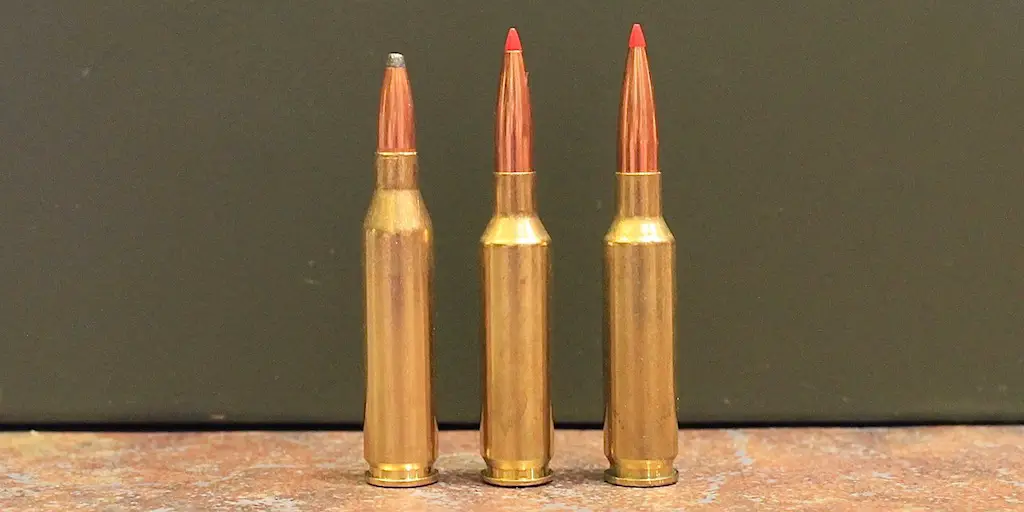
All three cartridges have the same rim .473″ diameter and they are all close enough in overall size that they are used in short-action rifles.
The other big difference between these cartridges is that the 6mm and 6.5mm Creedmoor were both purpose built as competition shooting cartridges and were designed to use the longest and heaviest bullets available for their caliber without intruding into the powder column. The 6mm Creedmoor was also intended for use from the start in semi-automatic rifles like the AR-10 as well as bolt action rifles.
For these reasons, long, heavy for caliber bullets will fit in the magazine and chamber in 6mm and 6.5mm Creedmoor rifles. Since those rifles also typically have a relatively fast rifling twist, they’ll accurately shoot heavier bullets with a high ballistic coefficient.
This is not the case with the .243 Winchester (or other cartridges based on the .308 Winchester like the .260 Rem for that matter).
For instance, most .243 Winchester loads top out at 100 grains and few .243 rifles have a fast enough twist rate (1:9″ and 1:10″ are very common) to stabilize bullets heavier than that.
On the other hand, 6mm Creedmoor rifles usually have a faster rifling twist (1:7.7″ in the case of the Ruger Precision Rifle), so the cartridge is commonly available with 103 grain, 105 grain, 107 grain, 108 grain, and 112 grain bullets. The 6mm Creedmoor can use the same lighter weight bullets as the .243 Winchester and fire them a bit faster (around 200fps with typical factory loads).
The 6.5 Creedmoor commonly uses 120gr, 140gr, and 143gr bullets.
Note: while the powder capacity figures listed below do give a good indication of the differences between the two cartridges, exact case capacities vary slightly according to the brand of brass used.
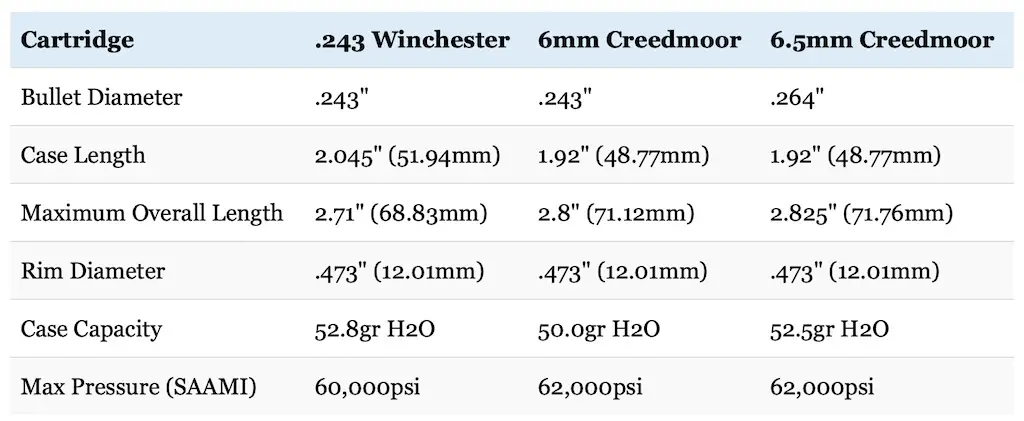
The table below compares compares the 3 cartridges using Hornady Precision Hunter ammo along with 2 max handloads for the 243 and 6mm Creedmoor using a 100gr InterLock taken from the Hornady reloading handbook. While the Precision Hunter ammo uses the same type of bullet for all 3 cartridges, the 243 and 6mm Creedmoor use different weight bullets with that line of ammo. So, I decided to include this those handloads to give an idea of how their performance compares when using the same type and weight bullet.
Specifically, those handloads use a 100gr InterLock with a .405 BC and the factory loads use a 90gr Hornady ELD-X (.409 BC) in .243 Winchester to a 103gr Hornady ELD-X (.512 BC) in 6mm Creedmoor, and a 143gr Hornady ELD-X (.625 BC) in 6.5 Creedmoor.
This data is for Hornady handloads and Hornady Precision Hunter factory ammo using a 200 yard zero and a 24″ barrel.
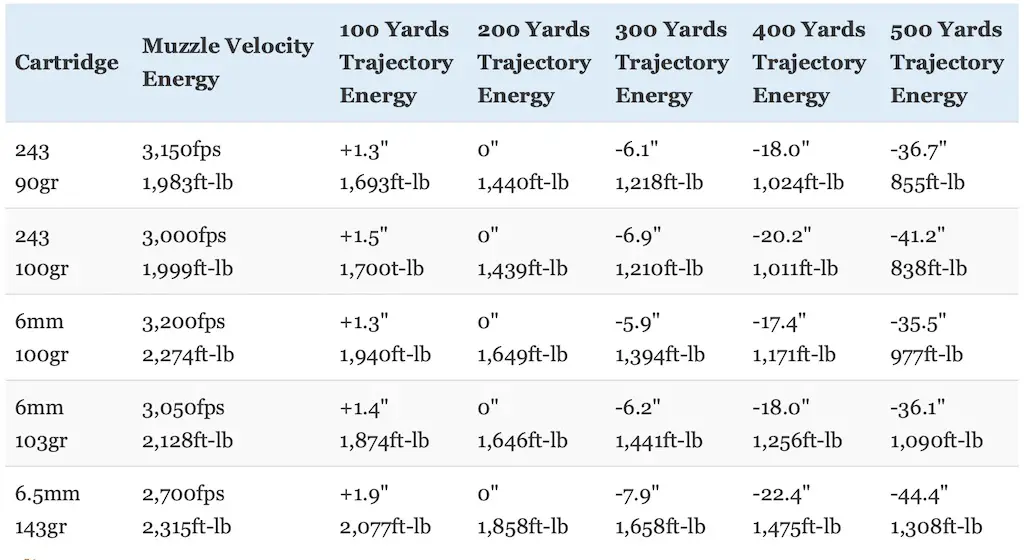
As you can see, the .243 Winchester and 6mm Creedmoor have a very similar trajectory with less than a half inch of difference in their point of impact at 500 yards when using the ELD-X bullets. The difference is even bigger with the InterLock bullets though and the 243 has almost 6″ more bullet drop than the 6mm Creedmoor at 500 yards.
The differences in trajectory are of course smaller at shorter ranges, but that 200fps advantage in muzzle velocity the 6mm Creedmoor has does result in a noticeable improvement in performance.
Both cartridges have a much flatter trajectory than the 6.5mm Creedmoor.
The 6mm Creedmoor also has about 7% more energy at the muzzle and about 27% more energy remaining at 500 yards than the .243 Winchester with the ELD-X bullets and about 14-17% advantage in energy with the InterLock bullets.
The 6.5 Creedmoor has a similar advantage over the 6mm Creedmoor in kinetic energy. Take that for what you will, but no animal will be able to tell the difference between an additional 100-200 ft-lbs of energy with a well placed bullet though.
Since this article is focused on the performance of these cartridges for hunting, I didn’t include any ballistic data past 500 yards in the table above. However, just to give you an idea of the superiority of the 6mm Creedmoor over the .243 Winchester at long range, consider this: the .243 Winchester has over 30″ more bullet drop than the 6mm Creedmoor at 1,000 yards when both cartridges have a 200 yard zero.
To further illustrate that same point, consider the supersonic ranges of the three cartridges. This particular .243 Winchester load drops below the speed of sound around 1,150 yards, but the 6mm Creedmoor stays supersonic out until around 1,375 yards and the 6.5 Creedmoor doesn’t cross the sound barrier until around 1,450 yards.
The chart below compares how much a 10 mile per hour crosswind impacts those same loads for each cartridge out to 500 yards.
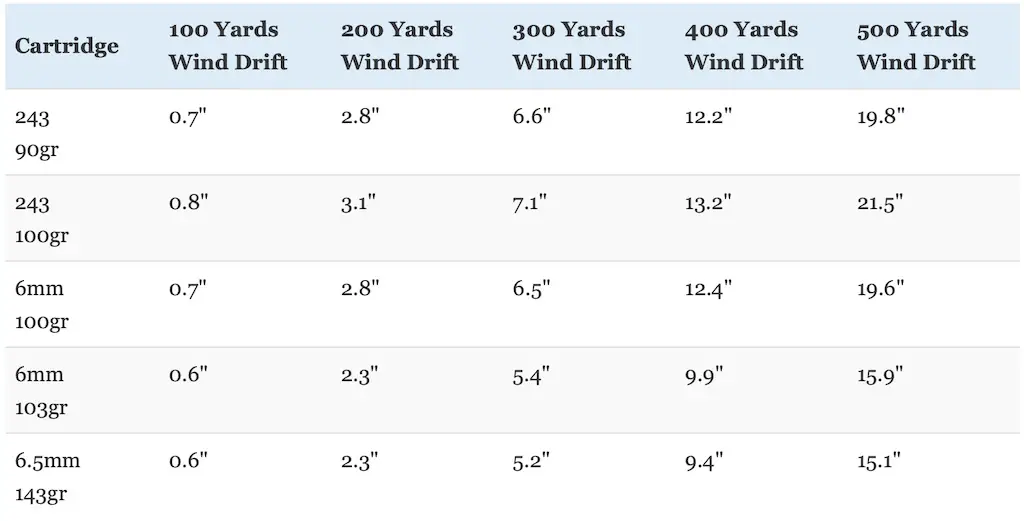
With just a minuscule .8″ separating them, the two Creedmoor cartridges have almost an identical amount of wind drift. However, the superior ballistic coefficient of the ELD-X bullets used by the 6mm and 6.5mm Creedmoor helps give those cartridges a significant advantage over the .243 Winchester in terms of wind drift of around 4-4.7″.
Even though the two InterLock loads use the exact same bullet, the 6mm Creedmoor does still have an advantage in wind drift over the 243 since it fires that bullet at a faster initial velocity. With almost 2″ of separation at 500 yards, the gap between them is much smaller.
All of these cartridges have a very mild recoil that most shooters and hunters should be able to handle. For example, when fired from a Ruger American Predator rifle, a .243 Winchester load firing an 90gr Nosler partition has slightly less recoil than a 103gr Hornady ELD-X from a 6mm Creedmoor. Both loads recoil a whole lot less than a 143gr Hornady ELD-X from a 6.5 Creedmoor.
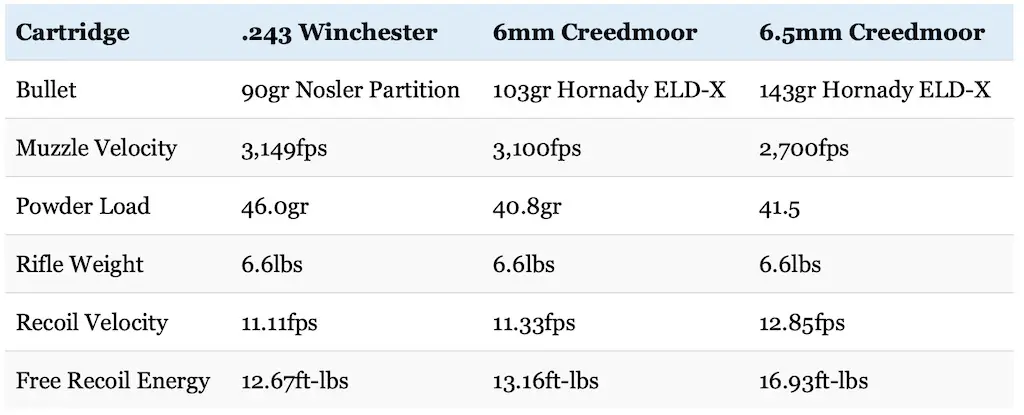
Felt recoil will vary from shooter to shooter and rifle to rifle, but free recoil energy is still a useful way to compare cartridges.
The 6.5mm Creedmoor isn’t a heavy recoiling magnum by any stretch of the imagination, but the .243 Winchester and 6mm Creedmoor have the edge in this respect. Don’t underestimate the impact that recoil has on the ability of a person to shoot accurately either. Regardless of how well a given person handles recoil, all other things being equal, they will absolutely shoot better with a milder recoil.
A mild recoil also facilitates with spotting misses and taking a rapid follow up shot both at the range and afield.
While all three cartridges are known for their exceptional accuracy, the 6mm and 6.5mm Creedmoor cartridges are usually better suited to use high BC and high SD, heavy for caliber match grade hunting bullets than the .243 Winchester because of the aforementioned faster rifling twist in rifles chambered for those cartridges that stems from their target shooting roots.
So where do we stand overall with the .243 Winchester, 6mm Creedmoor, and 6.5mm Creedmoor?
The 6mm Creedmoor has a trajectory that’s virtually the same as the .243 Winchester and significantly flatter than the 6.5 Creedmoor inside of 500 yards. The cartridge has a big advantage over the .243 Winchester in terms of wind resistance and is almost equal to the 6.5 Creedmoor in that regard. It also has a very mild recoil that’s nearly on par with the exceptionally light shooting .243 Winchester.
In short, the 6mm Creedmoor has the advantages of the .243 Winchester (flat trajectory and low recoil) and combines them with the best features of the 6.5mm Creedmoor (wind resistance and the ability to use long, low drag, high BC bullets). These factors make the 6mm Creedmoor very forgiving of range and wind estimation errors while at the same time helping to maximize the shooting abilities of the hunter to the greatest possible extent.
That being said, remember that the 6mm Creedmoor only offers a small upgrade in performance over the other two cartridges. The difference between the .243 Winchester and the 6mm Creedmoor can indeed make the difference in a tightly contested shooting match, but the gap between them is small enough that very few hunters will notice afield.
Since the two cartridges are virtual ballistic twins, they’re both suitable for hunting the same sort of game under the same conditions. Basically, hunters can take any game with the 6mm Creedmoor that they could with the .243 Winchester like deer, pronghorn, and even elk in some cases.
If you’d like a more detailed rundown of the strengths and weaknesses of the .243 Win, read this article:
243 vs 308 Win vs 7mm-08: Which Is Right For You?
The 6.5 Creedmoor is slightly larger and more powerful than the other two cartridges.
Here’s how each cartridge compares directly to the others in general terms.
6mm Creedmoor vs 6.5 Creedmoor
Compared to the 6mm Creedmoor, the 6.5 Creedmoor shoots heavier, larger diameter, and more aerodynamic bullets at a slower velocity.
6mm Creedmoor vs 243
Both use the same 6mm/.243” diameter bullets, but the 6mm Creedmoor was specifically designed to use longer, heavier, and more aerodynamic projectiles. Ballistics are very similar for the 6mm Creedmoor and .243 Winchester inside 500 yards, but the 6mm Creedmoor is much better suited for longer range shots since it can use those more aerodynamic bullets.
All things considered though, the three cartridges are very accurate, flat shooting, and hit hard enough for use on a wide variety of game at practical hunting ranges. Regardless of whether you’re using a .243 Winchester, a 6mm Creedmoor, or a 6.5mm Creedmoor, no pronghorn or deer will go far if you put a well constructed bullet into the vitals.
Of the three cartridges though, the 6.5 Creedmoor is likely the most popular of the three cartridges, followed by the .243 Winchester. The much newer 6mm Creedmoor is by far the least common. This is reflected in the prices, availability, and variety of factory ammunition and hunting rifles currently in production for each cartridge.
However, that’s during normal times and, as I’m writing this in 2021, we’re not living in normal times.
Interestingly, there is a surprisingly good selection of factory loaded 6mm Creedmoor ammunition these days. The same goes for rifles.
In fact, while the selection of 6.5 Creedmoor rifles and ammo are also good, things are as good, and maybe even a little better with the 6mm Creedmoor with the ongoing ammo shortage. Unfortunately, that’s not the case with the 243 Winchester. Ammo and rifles aren’t impossible to find, but they’re much harder to find than 6mm Creedmoor rifles and ammo right now
Who knows how long that will last, but it’s definitely something to keep in mind during the short term.
Best 6mm Creedmoor Ammo For Hunting
Unlike its bigger brother the 6.5 Creedmoor, there aren’t many options for factory 6mm Creedmoor hunting ammo right now. The list is slowly growing, but there are currently only a handful of options for loaded rifle ammunition the 6mm Creedmoor. Among others, this list includes the 103 grain ELD-X from Hornady, the 95 grain Barnes LRX BT, the 87 grain Hornady V-Max, and the 100gr Sierra GameKing.
If you don’t see something you like below, don’t fret too much. It seems like more and more 6mm Creedmoor ammo options for hunting are hitting the market each year. The cartridge is also well suited for handloaders and since it uses the same .243″ bullets as 6mm cartridges like the .243 Winchester, the 6x47mm Lapua, the 6XC, and the .240 Weatherby Magnum, there are a variety of great .243″ bullets currently available. Many of these are match bullets like the Hornady ELD Match, the Berger VLD, or other boat tail hollow point (BTHP) and open tip match (OTM) bullets that aren’t ideal for big game hunters.
Fortunately, there are also plenty of other good 6mm hunting bullets that will work very well in the 6mm Creedmoor.
Update July 2021: Ammo supplies finally look like they’re starting to recover. We still have a long way to go and selection is still nowhere near where it was back in 2019, but things are a lot better now than they were even 6 months ago.
Click the link below if you just want to quickly check what ammo is in-stock and ready to ship so you can hit the range and get ready for hunting season.
MORE IN-STOCK 6mm CREEDMOOR AMMO
Hornady Precision Hunter
Loaded with a high BC 103 grain ELD-X bullet, 6mm Creedmoor Precision Hunter ammunition has a flatter trajectory and carries more energy down range than any other factory loads for 6mm Creedmoor hunting ammo currently available. It’s also offers match grade accuracy. All in all, this is outstanding 6mm Creedmoor ammo for hunting medium game like deer and pronghorn.
- Bullet Type: Hornady ELD-X
- Bullet Weight: 103 grains
- Ballistic Coefficient (BC): .512 (G1) .258 (G7)
- Muzzle Velocity: 3,050 feet per second (2,127 ft-lbs of muzzle energy)
GET PRECISION HUNTER 6mm CREEDMOOR AMMO HERE
Also Available At: Brownells, Guns.com, & Lucky Gunner
Nosler Ballistic Tip
In addition to their ammo intended for competition shooting, Nosler also recently began offering factory loaded 6mm Creemoor hunting ammunition. Their 6mm Creedmoor Ballistic Tip ammo is great for hunters who want a really fast expanding bullet that rapidly delivers a tremendous amount of energy to game. If that sounds like you, then strongly consider using this ammunition for deer, feral hog, and pronghorn hunting.
- Bullet Type: Ballistic Tip
- Bullet Weight: 95 grains
- Ballistic Coefficient (BC): .379 (G1)
- Muzzle Velocity: 3,100 feet per second (2,027 ft-lbs of muzzle energy)
GET BALLISTIC TIP 6mm CREEDMOOR AMMO HERE
Nosler Trophy Grade
Nosler also offers their Trophy Grade hunting ammo in 6mm Creedmoor. So, if the Ballistic Tip ammo isn’t really your cup of tea and you prefer controlled expansion and high weight retention, then this ammo, which is loaded with their 90gr AccuBond bullet, is perfect for you. Like the Nosler Ballistic Tip ammo, their 6mm Creedmoor Trophy Grade ammo is also best suited for deer sized game.
- Bullet Type: AccuBond
- Bullet Weight: 90 grains
- Ballistic Coefficient (BC): .376 (G1)
- Muzzle Velocity: 3,200 feet per second (2,046 ft-lbs of muzzle energy)
GET TROPHY GRADE 6mm CREEDMOOR AMMO HERE
Also Available At: Palmetto State Armory
Barnes VOR-TX LR
Barnes currently offers their VOR-TX LR line of ammunition in 6mm Creedmoor and it’s another great choice for big game hunters who want the best possible performance at extended range for hunting. Not only are these LRX BT bullets specifically designed for the best aerodynamic performance possible, but they still offer the devastating terminal performance and high weight retention under a variety of hunting situations that Barnes bullets are known for.
Barnes VOR TX ammo is also an ideal choice if you’re hunting in states like California that mandate lead free 6mm Creedmoor ammo for hunting.
These bullets aren’t quite as heavy and have a little bit lower BC than the Hornady ELD-X, but they’re still very aerodynamic and very accurate. An excellent choice of 6mm Creedmoor ammo for hunting deer and pronghorn, the LRX BT still offers effective terminal performance and the deep penetration on larger game that’s essential when elk and red stag hunting.
- Bullet Type: Barnes LRX BT
- Bullet Weight: 95 grains
- Ballistic Coefficient (BC): .436 (G1) .215 (G7)
- Muzzle Velocity: 3,150 feet per second (2,094 ft-lbs of muzzle energy)
GET BARNES 6mm CREEDMOOR AMMO HERE
Also Available At: Brownells
Hornady Varmint Express
Like the .243 Winchester, the 6mm Creedmoor is also a really good varmint as well as big game hunting cartridge. For that reason, Hornady offers the 6mm Creedmoor as part of their Varmint Express line of ammo. Loaded with an 87 grain V-Max bullet at 3,210 feet per second, this is a very accurate and extremely flat shooting varmint hunting load at all practical ranges. These high velocity, rapidly expanding bullets aren’t really suitable for big game hunting, but they’re absolutely devastating on varmints and predators.
- Bullet Type: Hornady V-MAX
- Bullet Weight: 87 grains
- Ballistic Coefficient (BC): .400 (G1)
- Muzzle Velocity: 3,210 feet per second (1,990 ft-lbs of muzzle energy)
GET VARMINT EXPRESS 6mm CREEDMOOR AMMO HERE
Also Available At: Lucky Gunner
Final Thoughts On The 6mm Creedmoor
The 6mm Creedmoor is a very well designed cartridge that offers some marginal advantages over similar cartridges. While competition shooters were quick to adopt the new cartridge, the small benefits it offers over more established calibers like the .243 Winchester probably aren’t significant enough to justify making the switch for most hunters during normal times.
Unfortunately, we’re not living in normal times as I write this in September 2021.
As is the case with a handful of other newer cartridges, 6mm Creedmoor ammo has been much easier to find than 243 ammo throughout most of 2020 and 2021, even at the worst of the shortage. At this instant, I can find 3 different loads for it in-stock, which is more than I can say for the majority of other cartridges right now.
I know of several instances of people that I’ve known who have bought new rifles in a particular cartridge specifically because they could get ammo for it. This is one of those cases where I think doing that really makes sense in the short term.
It’s not a magical cartridge, but the 6mm Creedmoor does provide real benefits over the 243 Winchester. This is especially true when relative availability of the 2 cartridges during the ongoing ammo shortage are taken into account.
There’s no guarantee what the future may hold, but if I were in the market for a new hunting rifle and wanted something with great ballistics and minimal recoil that’s great for deer that I could actually purchase a good rifle and ammo for right now, then I’d be very seriously considering getting a rifle in 6mm Creedmoor.
This is especially true if you’re currently having a tough time finding ammo for other similar cartridges (like 243 Winchester). So, take all that for what you will.
If you’d like to learn more about how the 6.5 Creedmoor stacks up to a few other popular hunting cartridges, read the articles below.
260 Remington vs 6.5 Creedmoor vs 6.5×55 Swede
6.5 Grendel vs 6.5 Creedmoor: Which 6.5 Is Right For You?
25-06 vs 6.5 Creedmoor vs 270 Winchester: The Results Might Surprise You
6.5 PRC: Ultimate Guide To What You Need To Know
Do you have a rifle chambered in 6mm Creedmoor that you want to take on a hunt?
Book an incredible black bear hunt here.
Book an outstanding Africa hunting safari here.
Enjoy this article about the 6mm Creedmoor? Please share it with your friends on Facebook and Twitter.
John Snow’s article for Outdoor Life was used as a reference for the history of the 6mm Creedmoor. The Hornady 10th Edition (p231-237 and p317-322) reloading manual was also used as a reference for the history of the cartridges and provided data to compare their size and recoil. Nosler provided the data used to compare the recoil of the .243 Winchester (here). Chuck Hawks (here, here, and here) provided the case capacity for each cartridge. The data used to compare the trajectory of the cartridges was obtained from Hornady (here, here, and here). Maximum pressure obtained from SAAMI (p23 and p26 for the .243 and 6.5 Creed) and here for the 6mm Creedmoor. I used the Hornady Ballistic calculator and Shooters Calculator to compare wind drift, the range each bullet goes subsonic, and recoil for the cartridges.
Make sure you subscribe to The Big Game Hunting Podcast and follow The Big Game Hunting Blog on Facebook, Instagram, Twitter, and YouTube.
NEXT: 22-250 vs 223 vs 204 RUGER vs 220 SWIFT: CLASH OF THE SPEED DEMONS
NEXT: 101 BEST GIFTS FOR HUNTERS
John McAdams is a proficient blogger, experienced shooter, and long time hunter who has pursued big game in 8 different countries on 3 separate continents. John graduated from the United States Military Academy at West Point and is a veteran of combat tours with the US Army in Iraq & Afghanistan. In addition to founding and writing for The Big Game Hunting Blog, John has written for outdoor publications like Bear Hunting Magazine, The Texas State Rifle Association newsletter, Texas Wildlife Magazine, & Wide Open Spaces. Learn more about John here, read some of John’s most popular articles, and be sure to subscribe to his show: the Big Game Hunting Podcast.

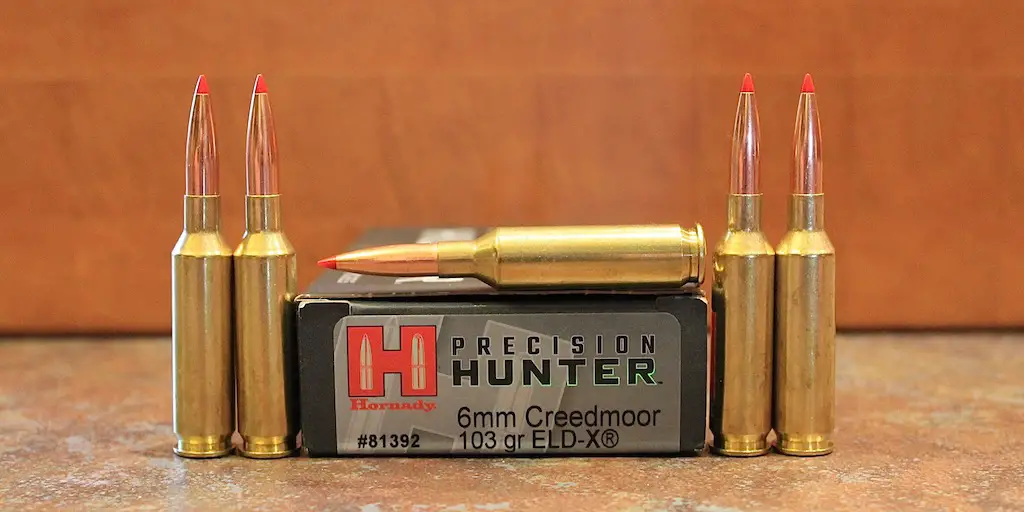

Someone keeps forgetting to tell John Whidden that he can’t spank the Creedmore fanboys at the Wimbledon matches with his 20 deg shoulder, low pressureed, overly tapered 243 Win.😉
Have you noticed the purveyors of the latest craze field hunting game are not allowing any 6mms to play?